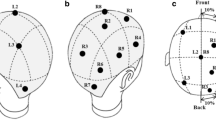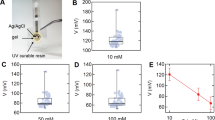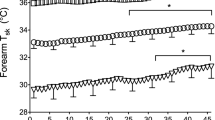Summary
Time courses of the rates of sweating, drippage and evaporation were studied in hot humid environments. Resting subjects wearing only briefs were exposed to humid conditions, before, during and after humid heat acclimation, so that different levels of skin wettedness could be studied on the entire body. In addition, local sweat rate was measured on the right upper limb, which was enclosed in a highly ventilated arm-chamber. Thus, the arm remained drier than the rest of the body surface. The results confirm that sweating efficiency is related to the skin wettedness level, and that the decline in intensity of sweating is linked to maximal inefficient sweat drippage before the onset of hidromeiosis. Comparison of general and local sweat decreases confirms that hidromeiosis originates from skin hydration. However it is likely that some factor related to blood content acts on the hidromeiotic process, at least after humid heat acclimation.
Access this article
We’re sorry, something doesn't seem to be working properly.
Please try refreshing the page. If that doesn't work, please contact support so we can address the problem.
Similar content being viewed by others
References
Brebner DF, Kerslake DMcK (1964) The time course of the decline in sweating produced by wetting the skin. J Physiol (Lond) 175: 295–302
Brown WK, Sargent F II (1965) Hidromeiosis. Arch Environ Health 11: 442–453
Candas V, Libert JP, Vogt JJ (1979a) Human skin wettedness and evaporative efficiency of sweating. J Appl Physiol: Respirat Environ Exercise Physiol 46: 522–528
Candas V, Libert JP, Vogt JJ (1979b) Influence of air velocity and heat acclimation on human skin wettedness and sweating efficiency. J Appl Physiol: Respirat Environ Exercise Physiol 47: 1194–1200
Candas V, Libert JP, Vogt JJ (1980) Effect of hidromeiosis on sweat drippage during acclimation to humid heat. Eur J appl Physiol 44: 123–133
Clifford JC, Kerslake DMck, Waddell JC (1959) The effect of wind speed on maximum evaporative capacity in man. J Physiol (Lond) 147: 253–259
Collins KJ, Weiner JS (1962) Observations on arm-bag suppression of sweating and its relationship to thermal sweat gland fatigue. J Physiol (Lond) 161: 538–556
Fox RH, Goldsmith R, Hampton IFG, Hunt TJ (1967) Heat acclimatization by controlled hyperthermia in hot-dry and hot-wet climates. J Appl Physiol 22: 39–46
Gagge AP (1937) A new physiological variable associated with sensible and insensible perspiration. Am J Physiol 120: 277–287
Gerking SD, Robinson S (1946) Decline in the rates of sweating of men working in severe heat. Am J Physiol 147: 370–378
Givoni B (1963) Estimation of the effects of Climate on Man: Development of a new thermal Index Haifa: Israel Inst of Technology Res Rep UNESCO
Gonzalez RR, Pandolf KB, Gagge AP (1974) Heat acclimation and decline in sweating during humidity transients. J Appl Physiol 36: 419–425
Hall JF (1963) Effect of vapor pressure on physiologic strain and body heat storage. J Appl Physiol 18: 808–811
Hammel HT, Jackson DC, Stolwijk JAJ, Hardy JD, Strömme SB (1963) Temperature regulation by hypothalamic proportional control with an adjustable set point. J Appl Physiol 18: 1146–1154
Hénane R (1972) La dépression sudorale en hyperthermie controllée chez l'Homme. J Physiol (Paris) 64: 147–163
Hertig BA, Riedesel ML, Belding HS (1961) Sweating in hot baths. J Appl Physiol 16: 647–651
Kamon E, Avellini B, Krajewski J (1978) Physiological limits to work in the heat for clothed men and women. J Appl Physiol: Respirat Environ Exercise Physiol 44: 918–925
Kerslake DMcK (1972) The stress of hot environments. Cambridge University Press, London
Kobayashi K, Horvath SM, Diaz FJ, Brandford DF, Drinkwater BL (1980) Thermoregulation during rest and exercise in different postures in a hot humid environment. J Appl Physiol: Respirat Environ Exercise Physiol 48: 999–1007
Ladell WSS (1945) Thermal sweating. Br Med Bull 3: 175–179
Libert JP, Candas V, Vogt JJ (1979) Effect of rate of change in skin temperature on local sweating rate. J Appl Physiol: Respirat Environ Exercise Physiol 47: 306–311
Mole RH (1948) The relative humidity of the skin. J Physiol (Lond) 107: 399–411
Nadel ER, Stolwijk JAJ (1973) Effect of skin wettedness on sweat gland response. J Appl Physiol 35: 689–694
Nielsen B (1974) Effect of changes in plasma Na+ and Ca+ ion concentration on body temperature during exercice. Acta Physiol Scand 91: 123–129
Ohara K (1966) Chloride concentration in sweat in relation to heat tolerance. In: Yoshimura H, Weiner JS (eds) Human adaptability and its methodology. Jap Soc Prom Sci, Tokio, pp 135–141
Peiss CN, Randall WC, Hertzman AB (1956) Hydration of the skin and its effect on sweating and evaporative water loss. J Invest Dermatol 26: 459–470
Randall WC, Peiss CN (1957) The relationship between skin hydration and the suppression of sweating. J Invest Dermatol 28: 435–441
Sargent F II (1962) Depression of sweating in man: so-called “sweat gland fatigueℝ. In: Montagna W, Ellis RA, Silver AF (eds) Advances in biology of skin, vol 3. Pergamon Press, London, pp 163–211
Thaysen JH, Schwartz IL (1955) Fatigue of the sweat glands. J Clin Invest 34: 1719–1725
Wyndham CH, Strydom NB, Morisson JF, Williams CG, Bredell GAG, Peter J (1966) Fatigue of sweat gland response. J Appl Physiol 21: 107–110
Author information
Authors and Affiliations
Rights and permissions
About this article
Cite this article
Candas, V., Libert, J.P. & Vogt, J.J. Sweating and sweat decline of resting men in hot humid environments. Europ. J. Appl. Physiol. 50, 223–234 (1983). https://doi.org/10.1007/BF00422161
Accepted:
Issue Date:
DOI: https://doi.org/10.1007/BF00422161




